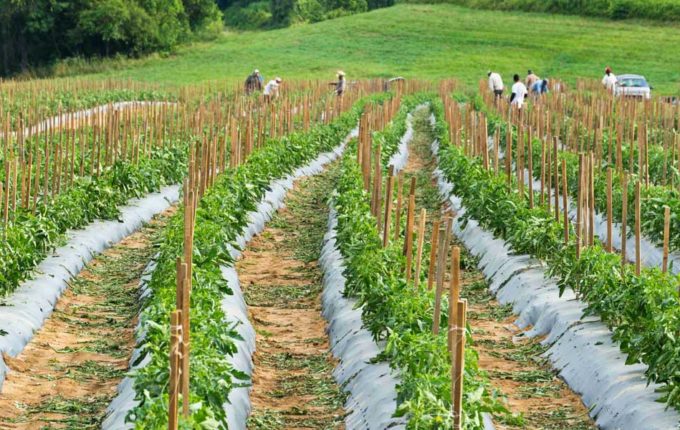The following commentary is by North Carolina Farm Bureau President Larry Wooten.
 Immigration reform has been discussed, debated and argued for years, but eventually concludes with the same tired result – “next year is the year!” To be blunt, fixing our worn-out immigration system does not require a rocket scientist. And this year needs to be the year.
Immigration reform has been discussed, debated and argued for years, but eventually concludes with the same tired result – “next year is the year!” To be blunt, fixing our worn-out immigration system does not require a rocket scientist. And this year needs to be the year.
What’s Going on with the Ag Workforce?
The short answer is, it’s changing. When I was still actively farming during the 1970s, 80s, and 90s, most of our farm workers were American citizens. But during the 90s that began to change, and farmers had to react to the change in their labor pool. What was happening over this time is American workers were taking other types of jobs for a number of reasons, but partly because people were becoming more educated and partly because of urbanization. Still needing workers, farmers began hiring more foreign-born workers because they were willing to do the job, and do it well.

Another trend farmers have been riding is mechanization. As farm workers have become more difficult to find, many farmers have looked to technology to help them get the job done. And for many farmers, technological advances have been a huge help in addressing workforce shortages.
The problem is that farmers aren’t magicians – eventually they reach a breaking point. And if we aren’t there yet, we’re getting close. Current technology only allows farmers to mechanize certain crops. For example, a lot of fruits and vegetables have to be harvested by hand. Take peaches: the fruit needs to be harvested carefully and at the right time because it’s not easy to make money selling unripe, bruised, and damaged produce. You can’t just have a machine shake the tree and pick up whatever falls. In these situations, farmers are reliant on immigrant labor since American workers aren’t interested in the jobs (more on that later). And deciding to mechanize isn’t an easy choice either; equipment can cost upwards of half a million dollars, and the return on investment isn’t always a sure thing.
A few years ago a study was done that looked at the H-2A visa program in North Carolina. As you may know, the visa program has many requirements, including: the employer must advertise the job locally; the employer must hire American citizens if they want the jobs; the employer must pay a federally-established hourly wage, which varies by state and in 2017 ranged from $10.38 to $13.79 (it’s $11.27 in NC). In 2011, North Carolina farmers requested 6,500 seasonal workers through the H-2A visa program. 268 Americans were interested in the jobs, of which 245 were hired. Of those 245, only 163 actually showed up for the first day of work, and only seven finished the growing season. That’s about 0.1 percent.
Imagine trying to build a road if only 0.1 percent of workers stayed with the project. How bad would your commute be then? Imagine trying to run a school if 99.9 percent of teachers quit before the end of the school year. What kind of education would our children receive?
WATCH:
What Does This Mean for the Rest of Us?
Because American farmers have come to rely so heavily on immigrant labor, their ability to keep feeding us is significantly connected with immigration policy. As a nation, we are incredibly lucky to have an abundant supply of healthy, affordable food and fiber. And as a state, we are also blessed with climate and soil that supports one of the most diverse agriculture sectors in the US.
But when farmers don’t have the workers they need at the times they need them, we all suffer. Produce rots in the field, costing the farmer thousands of dollars, limiting the supply of fresh and local produce, and indirectly affecting the price and quality of your food. Take this example from Georgia, where last year a blueberry farmer estimates he lost as much as $750,000 waiting on H-2A workers.
Some farmers will react by mechanizing in order to curb their losses. But others will likely switch from growing fruits and vegetables to less labor-intensive crops. Given the rise in consumer demand for fresh, local produce, the timing of these shifts is less than ideal. Citing a 2014 report by New American Economy, economist and agriculture policy consultant Dr. Stephanie Mercier summarized the dilemma:
Between 2000 and 2012, the study noted, US consumption of fresh produce rose by 10.5 percent, while US production rose only 1.4 percent. As a result, imports of fresh fruits and vegetable have increased by 38 percent over that period, with imports in several categories (such as lettuce, avocados, berries, and cherries) spiking well over 100 percent. The study cites labor supply challenges and H-2A visa shortcomings as key factors in a 27 percent decline in market share for US growers, accounting for $3.3 billion in missed GDP growth and $1.3 billion in unrealized farm income for 2012.
The second half of that quote points to a different problem for the rest of us, and that’s how a hamstrung agriculture sector hurts the economy, particularly rural economies. Agriculture is the foundation of our state’s economy, generating $84 billion and supporting about one out of every six jobs. Craig Regelbrugge of AmericanHort put it this way:
When we produce here we are generating thousands upon thousands of jobs that are not on the farm necessarily. They’re related to inputs that the farmer must buy in order to produce. They’re related to things that must happen after the crop or product leaves the farm. The multiplier effect for each farmworker is said to be somewhere between 2 and 3 jobs that are created here . . . If we become reliant on Canada, Mexico, Central America, and . . . China to feed us, most of the jobs that exist here in agriculture will go offshore to support us.
Less Talk, More Action
One of the remarkable things about today’s farmers is how they constantly manage to do more with less. We like to talk about how one farmer feeds 155 people, compared with only 26 back in 1960. So it should come as no surprise that farmers have found ways to adapt to changing trends in the agriculture labor force.
But it would be short-sighted to assume that farmers will continue to succeed in an environment that fails to meet their basic need for workers. Several weeks ago we took a delegation of farmers to meet with our Members of Congress to tell them how serious this problem is and to impress upon them the importance of fixing our immigration system. Senator Tillis pledged to find a solution during his watch, and many others have expressed their support and understanding. I’m calling on the entire North Carolina Congressional Delegation to face this challenge head-on and to find a solution that provides stability for our state’s largest economic driver.

